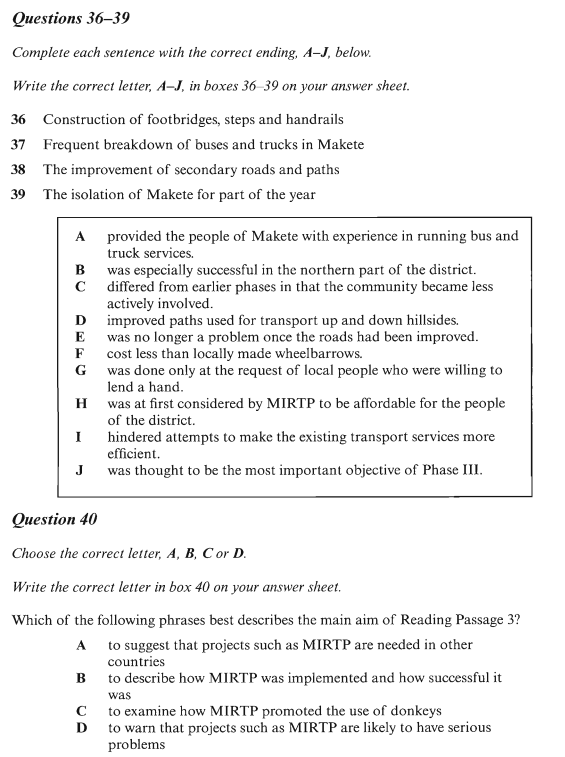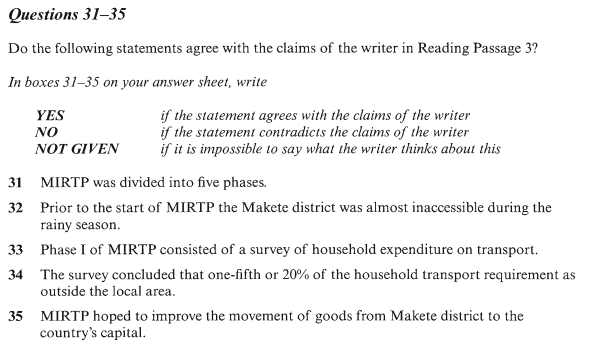剑桥雅思7阅读:Test2雅思阅读PASSAGE 3真题+答案+解析
发布时间:2020-12-03 关键词:剑桥雅思7阅读:Test2雅思阅读PASSAGE 3真题+答案+解析剑桥雅思7阅读:Test2雅思阅读PASSAGE 3真题+答案+解析,我们一起来看看吧!

Makete Integrated Rural Transport Project
Section A
The disappointing results of many conventional road transport projects in Africa led some experts torethink the strategy by which rural transport problems were to be tackled at the beginning of the 1980s.A request for help in improving the availability of transport within the remote Makete District of south-western' Tanzania presented the opportunity to try a new approach.
The concept of 'integrated rural transport was adopted in the task of examining the transport needs ofthe rural households in the district. The objective was to reduce the time and effort needed to obtainaccess to essentia! goods and services through an improved rural transport system. The underlyingassumption was that the time saved would be used instead for activities that would improve the social andeconomic development of the communities.' The Makete Integrated Rural Transport Project (MIRTP)started in 1985 with financial support from the Swiss Development Corporation and was co-ordinatedwith the help of the Tanzanian government.
Section B
When the project began, Makete District was virtually totally isolated during the rainy season.The regionalroad was in such bad shape that access to the main towns was impossible for about three months of theyear. Road traffic was extremely rare within the district, and alternative means of transport were restrictedto donkeys in the north of the district. People relied primarily on the paths, which were slippery anddangerous during the rains.
Before solutions could be proposed, the problems had to be understood. Little was known about thetransport demands of the rural households, so Phase l, between December 1985 and December 1987,focused on research.The socio-economic survey of more than 400 households in the district indicated thata household in Makete spent, on average, seven hours a day on transporting themselves and their goods,a figure which seemed extreme but which has also been obtained in surveys in other rural areas in Africa.Interesting facts regarding transport were found: 95% was on foot; 80% was within the locality; and 70%was related to the collection of water and firewood and travelling to grinding mills,
Section C
Having determined the main transport needs, possible solutions were identified which might reduce thetime and burden. During Phase Il, from January to February 1991, a number of approaches wereimplemented in an effort to improve mobility and access to transport.
An improvement of the road network. was considered necessary to ensure the import and export ofgoods to the district. These improvements were carried out using methods that were heavily dependenton labour. In addition to the improvement of roads, these methods provided training in the operation ofa mechanical workshop and bus and truck services, However, the difference from the conventionalapproach was that this time consideration was given to local transport needs outside the road network.Most goods were transported along the paths that provide short-cuts up and down the hllsides, but thepaths were a real safety risk and made the journey on foot even more arduous. It made sense to improvethe paths by building steps, handrails and footbridges.
It was uncommon to find means of transport that were more efient than walking but less technologicallyadvanced than motor vehicles. The use of bicycles was constrained by their high cost and the lack ofavailable spare parts. Oxen were not used at all but donkeys were used by a few households in thenorthern part of the district. MIRTP focused on what would be most appropriate for the inhabitants ofMakete in terms of what was available, how much they could afford and what they were willing to accept
After careful consideration,the project chose the promotion of donkeys - a donkey costs less than a bicycle- and the introduction of a locally manufacturable wheelbarrow.
Section D
At the end of Phase Il, it was clear that the selected approaches to Makete's transport problems had haddifferent degrees of success. Phase Ill, from March 199 I to March 1993, focused on the refinement andinstitutionalisation of these activities.
The road improvements and accompanying maintenance system had helped make the district centreaccessile throughout the year: Essential goods from outside the district had become more readily availableat the market, and prices did not fluctuate as much as they had done before.
Paths and secondary roads were improved only at the request of communities who were wiling toparticipate in construction and maintenance. However, the improved paths impressed the inhabitants, andrequests for assistance greatly increased soon after only a few improvements had been completed.
The efforts to improve the ffiency of the existing transport services were not very successful becausemost of the motorised vehicles in the district broke down and there were no resources to repair them.Even the introduction of low-cost means of transport was dfficult because of the general poverty of thedistnictThe locally manufactured wheelbarrows were still too expensive for all but a few of the households.Modifications to the original design by local carpenters cut production time and costs. Other localcarpenters have been trained in the new design so that they can respond to requests. Nevertheless, alocally produced wooden wheelbarrow which costs around 5000 Tanzanian silling (less than US$20) inMakete, and is about one quarter the cost of a metal wheelbarrow, is still too expensive for most people.Donkeys, which were imported to the district, have become more common and contribute, in particular,to the transportation of crops and goods to market. Those who have bought donkeys are mainly fromricher households but, with an increased supply through local breeding, donkeys should become moreaffordable. Meanwhile, local initiatives are promoting the renting out of the existing donkeys.
It should be noted, however, that a donkey, which at 20,000 Tanzanian silings costs less than a bicycle, isstill an investment equal to an average household's income over half a year' This clearly illstrtes the needfor supplementary measures if one wants to assist the rural poor.
Section E
It would have been easy to criticise the MIRTP for using in the early phases a 'top-down' approach, in whichdecisions were made by experts and officials before being handed down to communities, but it wasnecessary to start the process from the level of the govemmental authonities of the district. It would havebeen difficult to respond to the requests of vilagers and other rural inhabitants without the support andunderstanding of district authorities.
Section F
Today, nobody in the district argues about the importance of improved paths and inexpensive means oftransport But this is the result of dedicated work over a long period, particularly from the officers in chargeof community developmentThey played an essential role in raising awareness and interest among the ruralcommunities.
The concept of integrated rural transport is now well established in Tanzania, where a major program ofrural transport is just about to start. The experiences from Makete will help in this initiative, and MaketeDistrict will act as a reference for future work.
Makete综合乡郊交通项目
Section A
非洲许多传统公路运输项目令人失望的结果使一些重新考虑1980年代初解决农村运输问题的战略。请求帮助改善坦桑尼亚西南部偏远的Makete地区内的运输,提供了尝试新办法的机会。
“综合乡郊交通”的概念是在研究区内乡郊家庭的交通需要时采用的。目的是为了减少获得《本质》所需的时间和精力!通过完善的农村交通运输系统提供商品和服务。基本的假设是节省下来的时间将被用于促进社区的社会和经济发展的活动。“Makete综合农村交通项目(MIRTP)始于1985年,得到了瑞士发展公司的财政支持,并得到了坦桑尼亚政府的帮助。”
Section B
项目开始时,梅克特区在雨季几乎完全与世隔绝。该地区的公路状况糟糕,一年中有三个月左右无法进入主要城镇。该地区的道路交通极为稀少,在该地区的北部,可供选择的交通工具仅限于驴。人们主要依靠这些道路,因为在下雨的时候,这些道路很滑,很危险。
在提出解决方案之前,必须先了解问题。由于对农村家庭的交通需求了解甚少,因此l阶段(1985年12月至1987年12月)集中于研究。对该地区400多户家庭进行的社会经济调查显示,Makete的一户家庭平均每天花费7个小时来运输自己和货物,这个数字似乎很极端,但非洲其他农村地区的调查也得出了这个数字。关于交通的有趣事实发现:95%的人步行;80%在当地;70%与收集水和柴火以及前往磨粉厂有关,
Section C
在确定了主要的运输需要后,确定了可能减少时间和负担的解决办法。在1991年1月至2月的第1阶段期间,执行了若干办法,以改善交通的流动性和使用交通工具的机会。
改善公路网。被认为是必要的,以确保该地区的货物进出口。这些改进是使用严重依赖劳动力的方法进行的。除了改善道路之外,这些方法还提供了机械车间操作和公共汽车和卡车服务方面的培训,但是,与传统方法的不同之处在于,这次考虑到公路网络以外的当地运输需要。大多数货物都是沿着提供上下捷径的道路运输的,但这条道路确实存在安全隐患,使徒步旅行更加艰难。通过修建台阶、扶手和人行天桥来改善道路是有意义的。
很少能找到比步行更便捷,但在技术上却不如汽车先进的交通工具。自行车的使用由于成本高和缺乏可用的零部件而受到限制。在这个地区的北部,很少有人用牛,只有几户人家用驴。MIRTP关注的是什么对makete的居民最合适,比如什么是可用的,他们能负担多少,以及他们愿意接受什么
经过慎重考虑,该项目选择了驴的推广——驴比自行车便宜——以及引进当地制造的独轮手推车。
Section D
在阶段结束时,很明显,为解决Makete的运输问题所选择的办法取得了不同程度的成功。从199年3月1日到1993年3月,期的重点是这些活动的改进和制度化。
道路的改善和伴随而来的维护系统帮助该地区全年都成为中心地带:来自区外的必需品在市场上更容易买到,价格也不像以前那样波动很大。
只有在愿意参与建设和维护的社区的要求下,道路和次要道路才会得到改善。然而,改进后的道路给居民留下了深刻的印象,在仅仅完成了几项改进之后,要求援助的数量很快就大大增加了。
改善现有交通服务效率的努力并不十分成功,因为该区大部分机动车辆都坏了,又没有资源维修。






